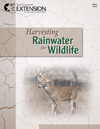 The majority of the water for Texans comes from a land resource called rangeland, the state’s largest watershed. Rangelands comprise sixty percent or ninety million acres of Texas land. Rangelands consist of grasslands, shrublands, marsh areas, deserts, and woodlands which are not used for commercial timber production. Rangelands support livestock production as well as provide habitat for native wildlife, but their most important function to Texans is as the State’s watershed.
The majority of the water for Texans comes from a land resource called rangeland, the state’s largest watershed. Rangelands comprise sixty percent or ninety million acres of Texas land. Rangelands consist of grasslands, shrublands, marsh areas, deserts, and woodlands which are not used for commercial timber production. Rangelands support livestock production as well as provide habitat for native wildlife, but their most important function to Texans is as the State’s watershed.
The precipitation that falls on Texas rangeland is a major source of surface flow and aquifer recharge. The majority of rivers and streams in Texas originate or flow through rangeland. As precipitation is the ultimate source of all fresh water, it has many destinations.
In an average rainfall year, it is estimated that forty-two percent of the precipitation falling on Texas is evaporated directly back into the atmosphere. An additional forty-seven percent is lost or used through transpiration (for plant growth). Only a little over one percent of the annual precipitation recharges aquifers and the remaining ten percent runs off to become stream flow.
Thus, precipitation that is currently captured directly for human use as fresh water in aquifers and surface water represents only a small proportion of the annual precipitation received, but management of the rangeland vegetation can redirect these percentages and is very critical to sustaining ample water for Texans.
The management of rangelands can have major impacts on the water available in Texas. Rangeland in a state of good health will provide Texans with a high quality water source, promote infiltration for ground water recharge, filter overland flow of water, provide forage for livestock production, and provide wildlife habitat.
Rangeland that is in an unhealthy state will have increased runoff with high nutrient and sediment content, and will not maintain as much soil moisture which is needed for the production of native plants required by domestic livestock and native wildlife.
Related Resources
Online Course: Rainwater Harvesting for Livestock and Wildlife
 Harvesting Rainwater for Wildlife
Harvesting Rainwater for Wildlife
 Rainwater Harvesting: Livestock
Rainwater Harvesting: Livestock